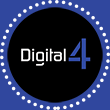
National Dance Tour / Combined Theatre Captions & Audio Description
Digital 4 were delighted to work on a Development project with Choreographer and Dancer Stuart Waters, Producer Vicki Balaam and Audio Describer and Theatre Captioner Willie Hamilton and successfully add pre-recorded MP3 files of audio-description as an output stream in our Venue software so that Captions and Audio Description could be offered as a combined output by a single operator.
Post Tour Report for Arts Council:
Digital 4 has been working on solutions to offer affordable access systems for smaller venues and small-scale touring shows, so the opportunity to work with Vicki and Stuart on Rockbottom was a great opportunity to develop and test new ideas.
RB had already committed to offer audio-description for the show recorded and output by Willie Hamilton.
We offered 2 options for the captioning.
Projected captions:
Pros:
Cost – Projected captions remove the need to use LED caption displays which are expensive to hire and bulky to tour. Most venues will have a projector which can be utilised.
Open Access – Projection offers “open access” where the client audience can sit anywhere and see the captions and so they do not need to declare any disability either when booking a ticket or on arrival at the venue.
FOH – there is no added work or pre-show training required for the FOH team.
Cons:
Projecting captions change the ascetic of the show. In this instance they appeared as 3 lines projected above the main playing area. This impacts on the deisgners’ “vision” and Stuart was concerned how it would affect the overall look of the show.
You need to ensure that there is a flat surface to project onto so that the captions are clear and this may mean touring a screen.
Captions on tablets
Pros:
Relatively cheap compared to LED caption units
Wireless transmission
Does not impact on show design
Cons:
“Closed Access” – clients need to self-declare and not everyone is comfortable to do so.
Tablets work best when there is a relatively short viewing distance to the stage area
Tablets can be disconcerting to the hearing audience around the user
Tablets offer no access for undeclared audience members. There are nearly 12 million people in the UK with varying degrees of hearing loss. Many people only refer to caption units a few times during a performance and they would not declare and use a tablet and so their experience is diminished.
POST-SHOW DISCUSSIONS
As part of the consultancy we observed that if you are going to make the show accessible then any post-show discussions must also be accessible to our client audience.
Live events such as these can, at present, only be accessed by using a speech-to-text reporter either on-site or remote. We introduced RB to MyClearText.
An STT Reporter uses specialist software to output speech live as text. This is then displayed so that the client audience can follow and join in the discussion.
RB used remote STT. An audio feed form the discussion is sent to the STTR by Skype. The STTR outputs text onto a web-page. This web-page is picked up at the venue and displayed.
Pros:
Remote STT is cheaper than on-site provision.
Cons:
It involves quite a lot of technical preparation to set up ensure the necessary good connectivity to work well. This was a struggle for RB whose SM was already overworked.
If the feeds are not excellent then the quality of output is massively reduced.
Cost – it will cost upwards of £200.00 for a 30 minute post-show discussion
GENERAL OBSERVATIONS
Offering good access invariably takes time and has to be integrated into the production schedule as early as possible.
Combining captions and pre-recorded audio-description output by a single operator could make accessing this type of show affordable. In the future we can explore using OSC commands and time-lines to automate the output and reduce cost further.
We used tablets on RB largely, I think, because adding open access using a projector at a late stage in the production process was too much of change in the ascetic. If we had been able to show Stuart the projections earlier in the process I think he might have been comfortable using this method and even have integrated them positively into the show
Using tablets and setting up remote STT impacts on the SMs and FOH pre-show set up. This needs to be accepted and fully accommodated into the schedule for the pre-show. It cannot be left to be done if/when there is time. This is not fair on the SM or FOH and makes for bad access.
Post-show discussions are simply too expensive to offer regular access via STT whether on-site or remote. A 20 show tour with post-show would cost a minimum of £4000.00 plus VAT. As a direct result of our collaboration with RB we are launching an app which will interface with our software and automatically output post-show discussions to any display device attached to our system. We estimate that this will offer about 90% of the efficacy of a well-connected remote STTR.
I can only applaud Vicki’s and Stuart’s commitment to making RB fully accessible and say how much I enjoyed working with them and how much positive progress I think we have made so far.
